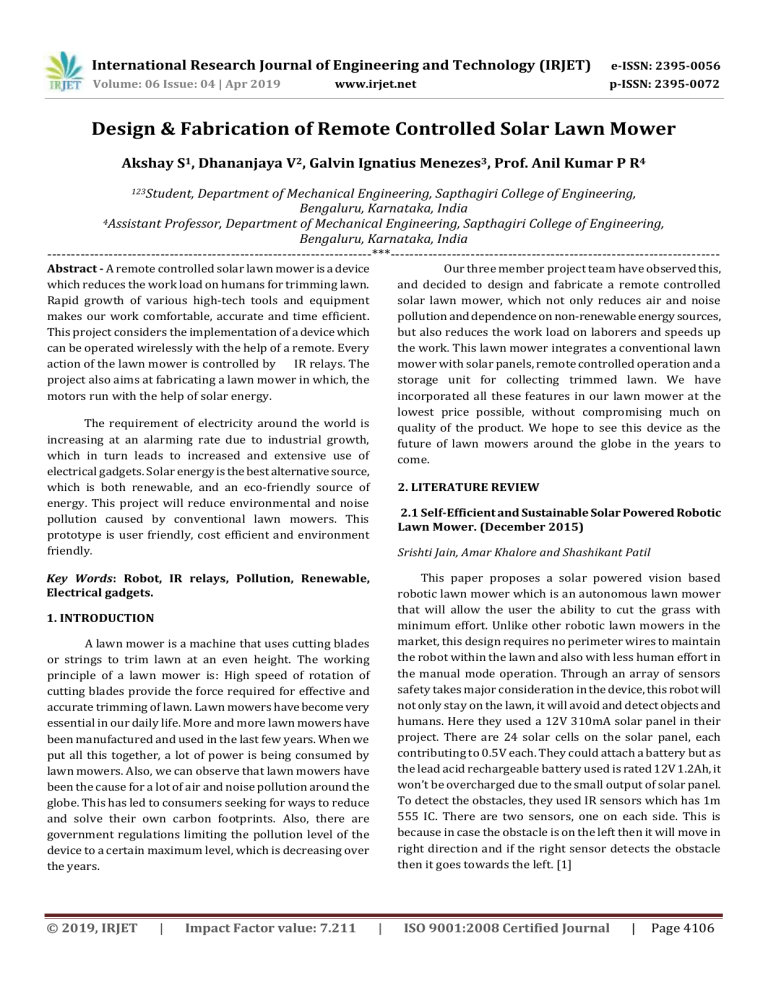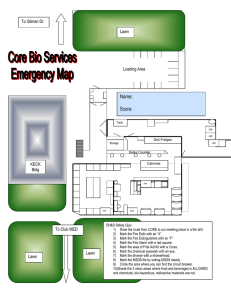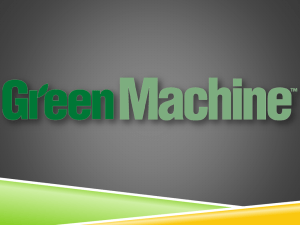IRJET- Design & Fabrication of Remote Controlled Solar Lawn Mower
advertisement

International Research Journal of Engineering and Technology (IRJET) e-ISSN: 2395-0056 Volume: 06 Issue: 04 | Apr 2019 p-ISSN: 2395-0072 www.irjet.net Design & Fabrication of Remote Controlled Solar Lawn Mower Akshay S1, Dhananjaya V2, Galvin Ignatius Menezes3, Prof. Anil Kumar P R4 123Student, Department of Mechanical Engineering, Sapthagiri College of Engineering, Bengaluru, Karnataka, India 4Assistant Professor, Department of Mechanical Engineering, Sapthagiri College of Engineering, Bengaluru, Karnataka, India ---------------------------------------------------------------------***---------------------------------------------------------------------Abstract - A remote controlled solar lawn mower is a device which reduces the work load on humans for trimming lawn. Rapid growth of various high-tech tools and equipment makes our work comfortable, accurate and time efficient. This project considers the implementation of a device which can be operated wirelessly with the help of a remote. Every action of the lawn mower is controlled by IR relays. The project also aims at fabricating a lawn mower in which, the motors run with the help of solar energy. Our three member project team have observed this, and decided to design and fabricate a remote controlled solar lawn mower, which not only reduces air and noise pollution and dependence on non-renewable energy sources, but also reduces the work load on laborers and speeds up the work. This lawn mower integrates a conventional lawn mower with solar panels, remote controlled operation and a storage unit for collecting trimmed lawn. We have incorporated all these features in our lawn mower at the lowest price possible, without compromising much on quality of the product. We hope to see this device as the future of lawn mowers around the globe in the years to come. The requirement of electricity around the world is increasing at an alarming rate due to industrial growth, which in turn leads to increased and extensive use of electrical gadgets. Solar energy is the best alternative source, which is both renewable, and an eco-friendly source of energy. This project will reduce environmental and noise pollution caused by conventional lawn mowers. This prototype is user friendly, cost efficient and environment friendly. 2. LITERATURE REVIEW 2.1 Self-Efficient and Sustainable Solar Powered Robotic Lawn Mower. (December 2015) Srishti Jain, Amar Khalore and Shashikant Patil This paper proposes a solar powered vision based robotic lawn mower which is an autonomous lawn mower that will allow the user the ability to cut the grass with minimum effort. Unlike other robotic lawn mowers in the market, this design requires no perimeter wires to maintain the robot within the lawn and also with less human effort in the manual mode operation. Through an array of sensors safety takes major consideration in the device, this robot will not only stay on the lawn, it will avoid and detect objects and humans. Here they used a 12V 310mA solar panel in their project. There are 24 solar cells on the solar panel, each contributing to 0.5V each. They could attach a battery but as the lead acid rechargeable battery used is rated 12V 1.2Ah, it won’t be overcharged due to the small output of solar panel. To detect the obstacles, they used IR sensors which has 1m 555 IC. There are two sensors, one on each side. This is because in case the obstacle is on the left then it will move in right direction and if the right sensor detects the obstacle then it goes towards the left. [1] Key Words: Robot, IR relays, Pollution, Renewable, Electrical gadgets. 1. INTRODUCTION A lawn mower is a machine that uses cutting blades or strings to trim lawn at an even height. The working principle of a lawn mower is: High speed of rotation of cutting blades provide the force required for effective and accurate trimming of lawn. Lawn mowers have become very essential in our daily life. More and more lawn mowers have been manufactured and used in the last few years. When we put all this together, a lot of power is being consumed by lawn mowers. Also, we can observe that lawn mowers have been the cause for a lot of air and noise pollution around the globe. This has led to consumers seeking for ways to reduce and solve their own carbon footprints. Also, there are government regulations limiting the pollution level of the device to a certain maximum level, which is decreasing over the years. © 2019, IRJET | Impact Factor value: 7.211 | ISO 9001:2008 Certified Journal | Page 4106 International Research Journal of Engineering and Technology (IRJET) e-ISSN: 2395-0056 Volume: 06 Issue: 04 | Apr 2019 p-ISSN: 2395-0072 www.irjet.net 2.2 Automated Solar Grass Cutter (February 2017) 2.4 Solar Based Grass Cutting (January-June 2017) Ms. Rutuja A. Yadav, Ms. Nayana V. Chavan, Ms. Monika B. Patil, Prof. V.A. Mane Ms. Bhagyashri R. Patil, Mr. Sagar S. Patil For human enlargement in many countries there are studies and trials going on the solar energy and the wind energy, so they made their new concept solar power grass cutting machine. In this concept they cut the grass on the agricultural land or small plants in lawns and gardens. The design of solar powered agricultural equipment will include direct current (DC) motor, a rechargeable battery, solar panel, a stainless steel blade and control switch. The automatic grass cutting machine is going to perform the grass cutting operation by its own which means no manpower is mandatory. The purpose of the project here is to design and build a remote controlled grass cutter. They have used many components for preparing grass cutter like DC Motor for rotating the wheels and blade, wheels, battery, Solar panel, IR sensor, Collapsible blade. There are two main components such as transmitter and receiver. Transmitter continuously transmits the rays if any obstacle come in front of grass cutter then the rays are reflected back towards the receiver. The receiver receives the signal in the serial form from encoder but microcontroller requires parallel data for communication so receiver sends data to decoder to convert data in the parallel form and then it is passed to microcontroller. [4] In this paper they are trying to make a daily purpose robot which is able to cut the grasses in lawn. The system will have some automation work for guidance and other obstacle detection and the power source that is battery and a solar panel will be attached on the top of the robot because of this reduces the power problem. The grass cutter and vehicle motors are interfaced to an 8051 family microcontroller that controls the working of all the motors. It is also interfaced to an ultrasonic sensor for object detection. The microcontroller moves the vehicle motors in the forward direction in case no obstacle is detected. If in case obstacle is detected by the sensor, then the microcontroller stops the grass cutter motor so as to avoid any damage to the object/human/animal coming. [2] 2.3 Design and Implementation of Automatic Solar Grass Cutter (April 2017) Bidgar Pravin Dilip, Nikhil Bapu Pagar, Vickey S. Ugale, Sandip Wani, Prof. Sharmila M. This paper describes manually handled device is commonly used for cutting the grass over the field which creates pollution and loss of energy. Automatic solar grass cutter which will reduce the effort required for cutting grass in the lawns. Also solar power will be used to provide the driving force for the cutter and various sensors will be used to detect and avoid the unnecessary objects in the field during operation. It consists of microcontroller arduino ATmega328p, IR sensors, LCD display for better response and understanding to the user. This paper will analyze the operation and working principle of the Automatic Grass Cutter. The other objective is that the automatic lawn cutter has to differentiate between grass and concrete while monitoring its surroundings continuously. They wanted an ultrasonic sensor to sense it the lawn cutter was heading into an object. Safety is the main concern while designing the lawn cutter. As it has blades they wanted their lawn cutter not to be in operating mode if it was being held in the air by the user. The design contains a microcontroller, multiple sensors and a solar charging system. Adding these elements together, they got their robotic lawn mower. Knowing that the user would be randomly holding the robot they needed a sensor to detect orientation. They decided to go with the one that work best with solar charging. The nickel-metal hydride (NiMH) was found to be the best because given a low charging current, it will not overcharge. [3] © 2019, IRJET | Impact Factor value: 7.211 3. BLOCK DIAGRAM Fig (1): Block diagram of working | ISO 9001:2008 Certified Journal | Page 4107 International Research Journal of Engineering and Technology (IRJET) e-ISSN: 2395-0056 Volume: 06 Issue: 04 | Apr 2019 p-ISSN: 2395-0072 www.irjet.net 4. PROJECT OBJECTIVES The device which we have developed is a lawn mower which runs electrically by using DC motors which directly power the wheels, rotating brush and the cutter threads. The motors are powered using lead acid batteries which can be charged with the help of renewable solar energy. IR relays are used for controlling the movements of the device. The entire device is focused on lowering the fabrication and manufacturing costs to make it affordable to common man. Fig (3): IR 4 channel relay 5.3 CUTTER THREAD: The rotation of the cutter thread provides the force required to trim the lawn efficiently and evenly. We have used a nylon wire of 3 mm diameter for the purpose. The projected length of the wire is 40 cm. The main objectives of our project are: 1) To build an economic remote controlled solar lawn mower. 2) To develop a user friendly control system. 3) To design, fabricate and analyse the remote controlled lawn mower. 5. COMPONENTS USED IN SOLAR LAWN MOWER 5.1 DC WIPER MOTOR: It is a device which converts electrical form of energy into mechanical form. There are many kinds of DC motors such as separately excited DC motor and self-excited DC motor. DC motor is powered by DC current. There are various ways in which DC motors are advantageous when compared to AC motors, one of which is that DC motors provide excellent control of speed. We have used 12V 60rpm motor for wheels, 12V 80rpm for rotation of brush and 12V 150rpm for rotation of cutter threads. Fig (4): Cutter thread 5.4 BATTERY: Battery will provide the energy required for working of the device. The battery connected to any component should provide enough power to drive the component under load. We have used three batteries of 12V 15Ah each: Two to drive the wheels, and another to drive the cutter thread and rotating brush. Fig (2): DC Wiper motor 5.2 IR RELAY: A relay can be defined as a switch that is applied with electrical signal which in turn connects or disconnects another circuit. An IR relay is a device in which the relay can be operated wirelessly by a remote, with the help of Infrared signals. IR technology requires a line-ofsight between the transmitter and receiver units. We are using 2 sets of 4 channel IR relays in our project. © 2019, IRJET | Impact Factor value: 7.211 Fig (5): Battery 5.5 WHEELS: These will be required for motion of the lawn mower. The choice of wheels used largely depends on the | ISO 9001:2008 Certified Journal | Page 4108 International Research Journal of Engineering and Technology (IRJET) e-ISSN: 2395-0056 Volume: 06 Issue: 04 | Apr 2019 p-ISSN: 2395-0072 www.irjet.net shape and size of the lawn. It will also depend on the ground clearance of the lawn mower. We have implemented rubber wheels of 18cm diameter in our project. 5.8 CHASSIS: Chassis is the internal frame that supports the entire device. It is the back bone of the device. All the systems and components such as the motors, IR relays, rotating brush, batteries, wheels, storage unit, solar panel and cutter thread are held together as one by the chassis. The overall strength of the device is greatly affected by the design and material used in the construction of the chassis. Chassis also provide protection to some delicate components. The rods used in the construction of the chassis in this project are of mild steel material of one inch square cross-section. The chassis is of 2.5 x 1.6 feet dimensions. The shaft connecting the two front wheels is circular with an external diameter of two inches, and this shaft too is made of mild steel, Fig (6): Wheels 5.6 ROLLER BRUSH: It is used for collecting the lawn which has been trimmed by the motor. As the brush rotates, it guides the trimmed lawn into a storage unit. We have used a roller brush of length 33cm and 10cm diameter. Fig (8): Chassis Fig (7): Roller brush 5.9 SOLAR PANEL: The solar panel is bolted onto a supporting bar which is attached to the frame. This supporting bar is located at the rear end of the device, and is inclined at an angle of 20o. Electrical wires are used to connect the solar panel to the batteries for charging purpose. We have made use of a 12 V, 5 W solar panel in this project. This solar panel charges a battery to full capacity in a time duration of about 18 hours. Thus, this device can be used for gardening at home, where there is no requirement for daily usage of the device. The solar panel can be inclined to face the sun directly, for maximum utilization of sunlight. 5.7 STORAGE UNIT: The trimmed lawn, with the help of a rotating brush is guided into a storage unit. The storage unit we have used is of length 34cm, breadth 14cm and height 12cm. Collecting trimmed lawn improves the ambience of the area, as trimmed lawn dries quickly and spoils the scene of green lawn by forming lumps of dried grass throughout. The collected lawn can be dried, converted into compost and used as manure for a variety of vegetation. Fig (9): Solar Panel Fig (8): Storage unit © 2019, IRJET | Impact Factor value: 7.211 | ISO 9001:2008 Certified Journal | Page 4109 International Research Journal of Engineering and Technology (IRJET) e-ISSN: 2395-0056 Volume: 06 Issue: 04 | Apr 2019 p-ISSN: 2395-0072 www.irjet.net 6. PHOTOVOLTAIC PRINCIPLE 7.2 3D MODEL DESIGNED USING UG-NX SOFTWARE Conversion of light energy into electrical energy is based on a phenomenon called photovoltaic effect. Photo-voltaic effect can be observed in nature in a variety of semiconductors. When photons from the sun are absorbed in a semiconductor, it creates free electrons with high energy levels. There must be an electric field to induce these high energy electrons to flow out of the semi-conductor to do useful work. A junction of materials, which have different electrical properties, provides the electric field in most solar cells for the photon interaction in a semiconductor. A solar cell consists of 1) Semi –conductor in which electron hole pairs are created by the absorption of incident solar radiation. 2) Region containing a drift field for charge separation. 3) Charge collecting front and back electrodes. 8. OBSERVATIONS & CALCULATIONS 8.1 OBSERVATIONS OF THE LAWN MOWER 1) 2) 3) 4) 5) 6) 7) 8) 9) 10) 11) 12) 13) 14) Fig (10): Photovoltaic principle 7. FABRICATED MODEL v/s DESIGNED MODEL Wheel diameter, d Rotation speed of wheels, N1 Rotation speed of brush, N2 Rotation speed of cutter thread, N3 Mass of the lawn mower, m Length of storage unit, l Breadth of storage unit, b Height of storage unit, h Diameter of blade, d2 Mass of the cutter, m2 Length of blade, l2 Power capacity of solar panel, P’ Voltage rating of battery, V’ Storage capacity of battery = 18 cm = 60 rpm = 80 rpm = 150 rpm = 30 Kg = 34 cm = 14 cm = 12cm = 3 mm = 0.5 Kg = 40 cm =5W = 12 V = 7.5 Ah 8.2 CALCULATIONS OF THE LAWN MOWER 7.1 FABRICATED MODEL Speed of lawn mower Circumference of wheel C = 3.142 x d=3.142x18 = 56.54 cm Speed of movement of the device = (N1/60) x C = (60/60) x 56.54x10-2 = 0.57 m/s = 0.57 x 18/5= 2.052 km/hr Power required to drive the lawn mower Force F = m x g = 30 x 9.81 = 294.3 N © 2019, IRJET | Impact Factor value: 7.211 | ISO 9001:2008 Certified Journal | Page 4110 International Research Journal of Engineering and Technology (IRJET) e-ISSN: 2395-0056 Volume: 06 Issue: 04 | Apr 2019 p-ISSN: 2395-0072 www.irjet.net Power, P = F x V = 294.3 x 0.57 = 167.751W 9. WORKING Power produced by wheel motor 1) The solar powered lawn mower has solar panels mounted in a particular arrangement at an angle of 45 degrees in order to receive maximum solar radiation from the sun. 2) These solar panels convert solar energy into electrical energy as studied earlier. This electrical energy is stored in batteries by using a solar charger. 3) The main function of the solar charger is to increase the current from the panels while batteries are charging. It also disconnects the solar panels from the batteries when they are fully charged and connects them when the charge in batteries is low. 4) The electrical energy stored in the battery is transmitted to various motors through connecting wires. 5) From the motors, the power is transmitted to the wheels, brush and cutter threads. Effective mass on each motor, m’ = m/2 = 30/2 = 15 kg Force F = m’ x g = 15 x 9.81 = 148N Radius of the wheel, r = d/2 = 0.18/2 = 0.09 m Torque produced T= F x r1 = 148 x 0.09= 13.32 Nm Power = (2 x π x N1 x T)/60 = (2 x 3.142 x 60 x 13.32)/60 = 83.7 W Total power produced by both wheels P = 83.7 x 2 = 167.4W 10. PERFORMANCE FACTORS Volume of the storage unit The device has to be evaluated on some factors to find out its working efficiency, and if it is convenient practically or not. Some of the factors are: Volume V = l x b x h = 34 x 14 x 12= 5712 cm3 Angular velocity of the blade 1) Cutting Time: It is one of the basic factors, which effects the performance of the device to a great extent. It is defined as the time required by the lawn mower to trim lawn in a unit area. As time is the most valuable resource in the present days, this factor becomes most important in determining the usability of the device. ω= 2πN3/60= 2 x π x (150)/60 = 15.70 rad/sec Torque produced by the blade Area of cross section of the cutter thread A = πd22/4 = π x (0.3)2/4 = 0.07cm2 2) Trimmed lawn condition: Whether the cut made to the lawn is clean or not, and if the height of the trimmed lawn is uniform or not are two very important factors in determining the performance of the device. The desired outcomes are uniform and clean trimming of lawn. Volume of the cutter thread V = A x l2 V = 0.07 x 40 = 2.8 cm3 Weight of the cutter W2 = m2g= 0.5 x 9.81 = 4.9N 3) Movement Pattern: Movement pattern is an important factor. If the lawn mower moves over a previously trimmed area, it leads to wastage of energy and time. Hence, the movement pattern must be decided before-hand to avoid this un-necessary wastage of resources. Torque T = W2 x l2/2 = 4.9 x 0.4/2 = 0.98Nm Force produced by the blade Fc = m2 (l2/2) ω2 = 0.5 x (0.3/2) x (15.7)2 =18.5N Battery charging time 4) Power requirements: Power requirement decides the efficiency of the device. The power requirement of the device decides the energy consumed for trimming a unit area of lawn. More the power requirement, more is the energy required to trim unit area of lawn. Current produced by solar panel I = P’/V’ = 5/12 = 0.416 A Charging time = Battery capacity/current = 7.5/ 0.416 = 18 hrs © 2019, IRJET | Impact Factor value: 7.211 | ISO 9001:2008 Certified Journal | Page 4111 International Research Journal of Engineering and Technology (IRJET) e-ISSN: 2395-0056 Volume: 06 Issue: 04 | Apr 2019 p-ISSN: 2395-0072 www.irjet.net 11. ADVANTAGES [4] Solar Based Grass Cutting (January-June 2017) Ms. Bhagyashri R. Patil, Mr. Sagar S. Patil 1) The device reduces work load on humans. 2) It has simpler design than most commercial mowers. 3) This lawn mower is cheaper than most commercial lawn mowers. 4) It can be operated wirelessly from a distance. 5) It aids elderly users or those with disabilities. 6) The collected lawn can be used as fertilizers for a variety of vegetation. 12. CONCLUSIONS Our project entitled “Design and Fabrication of Remote Controlled Solar Lawn Mower” is successfully completed and the results obtained are satisfactory. This prototype can be further modified for commercial use by increasing its efficiency and reducing its cost. This project is has many advantages when compared to a conventional lawn mower, for instance: No fuel cost, no pollution and no fuel residue, less wear and tear because of less number of moving components, and the devices can be operated wirelessly. The device can be easily handled and reduces burden on humans. India is a country with abundance of sunlight. Hence it is important that we make use of this renewable source of energy in replacement for other nonrenewable sources which get depleted over time. Solar energy is also pollution free, and hence doesn’t harm the environment. The only drawbacks in using solar energy are that the initial investments and the time required to charge the device are high, At present, in order to curtail global warming and ozone depletion, the Government of India is offering subsidy for the solar equipment. Industries are producing these solar equipment in a mass scale. This leads to reduction of cost of the system over time. So in the near future, there iis going to be much more use of solar energy around India. 13. REFERENCES [1] Self-Efficient and Sustainable Solar Powered Robotic Lawn Mower. (December 2015) Srishti Jain, Amar Khalore and Shashikant Patil [2] Automated Solar Grass Cutter (February 2017) Ms. Rutuja A. Yadav, Ms. Nayana V. Chavan, Ms. Monika B. Patil, Prof. V.A. Mane [3] Design and Implementation of Automatic Solar Grass Cutter (April 2017) Bidgar Pravin Dilip, Nikhil BapuPagar, Vickey S. Ugale, SandipWani, Prof. Sharmila M. © 2019, IRJET | Impact Factor value: 7.211 | ISO 9001:2008 Certified Journal | Page 4112




